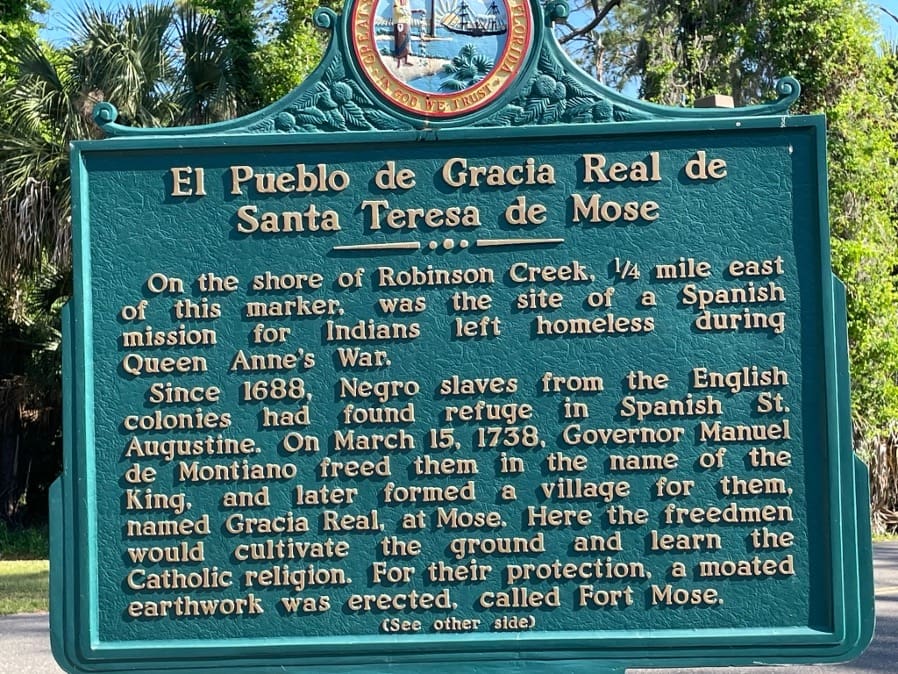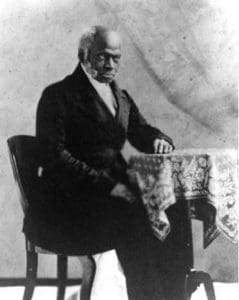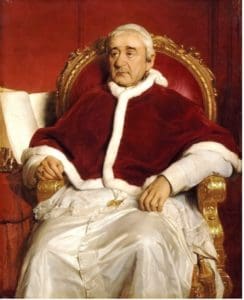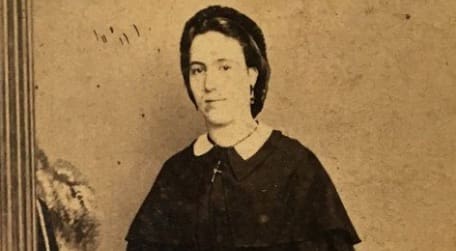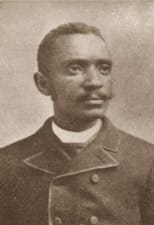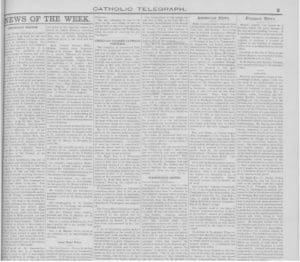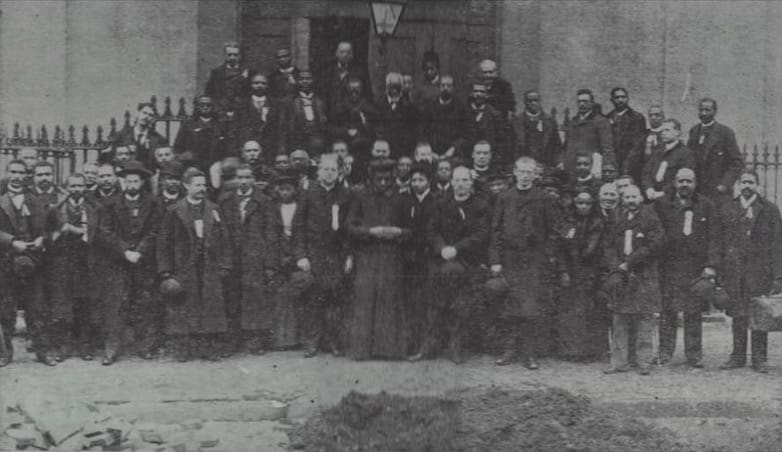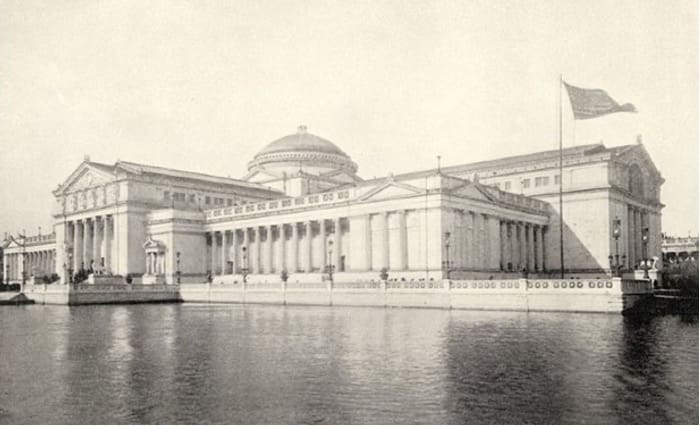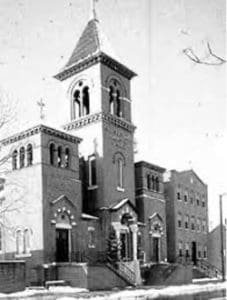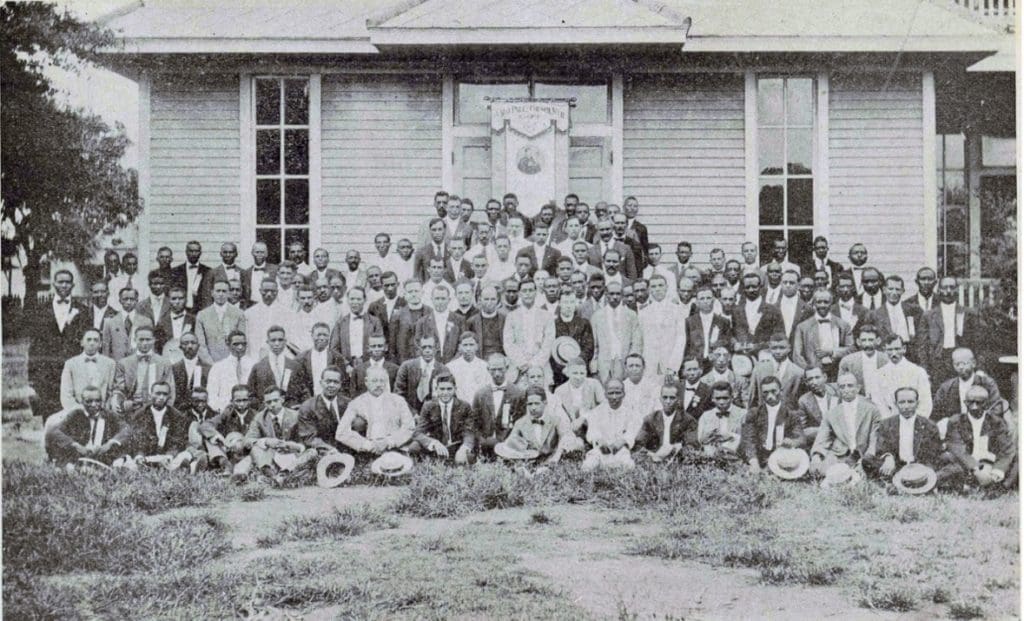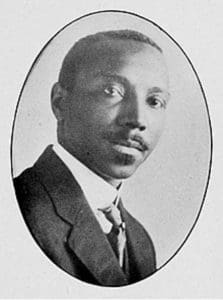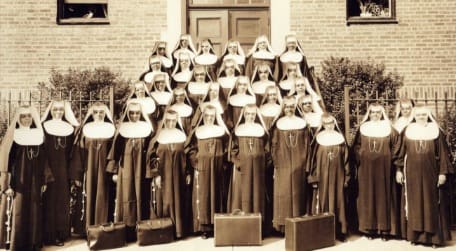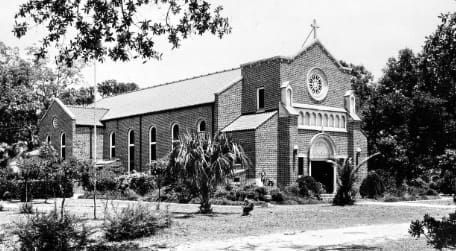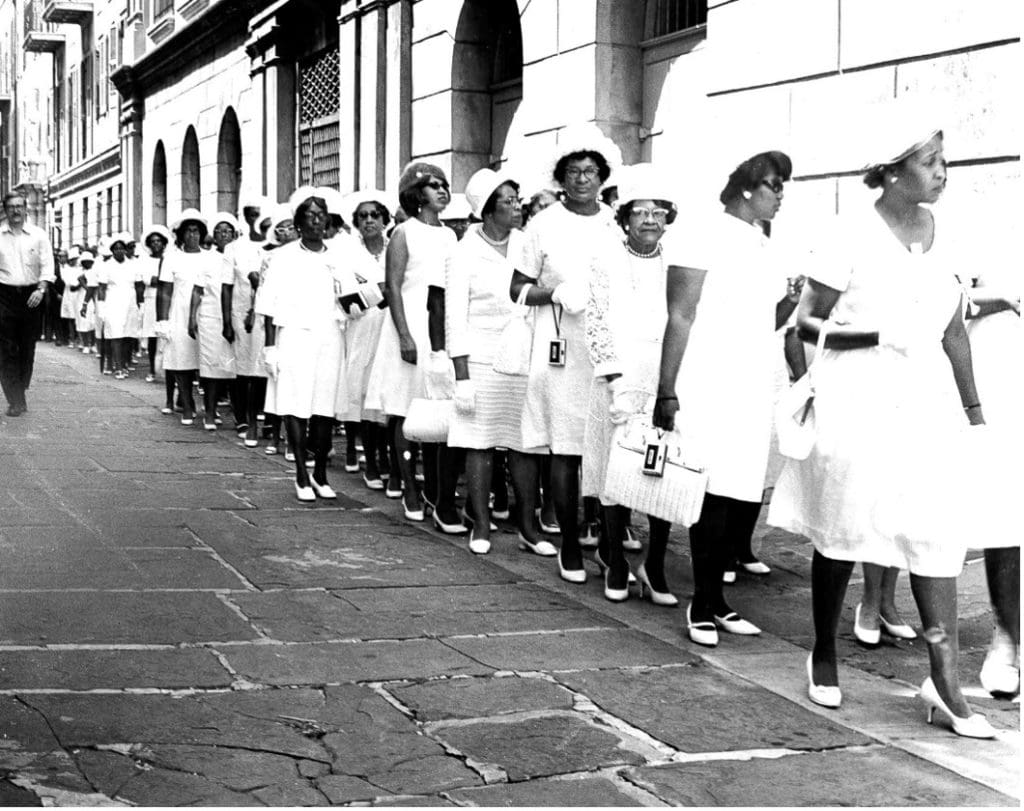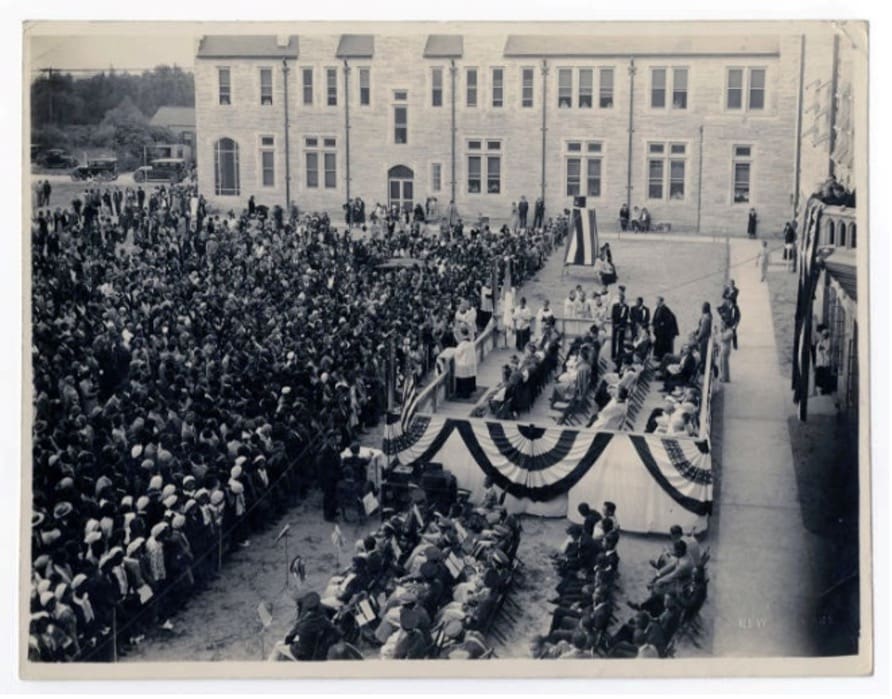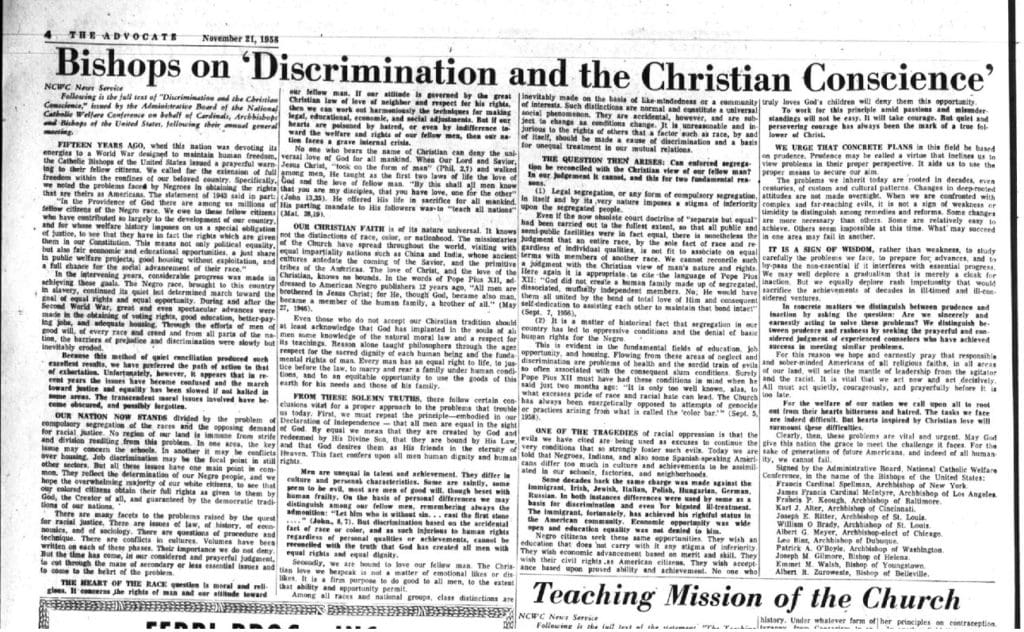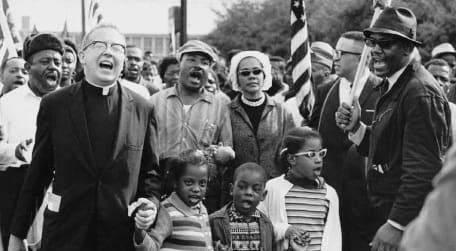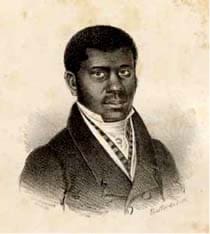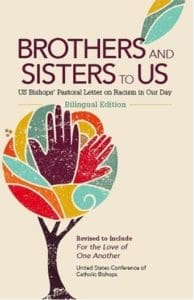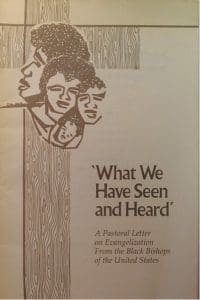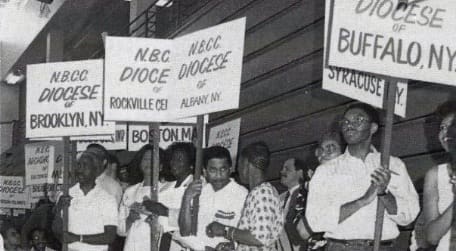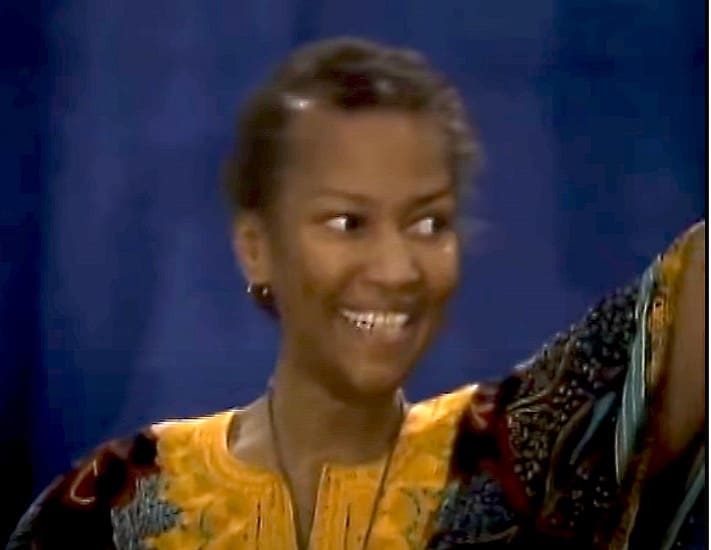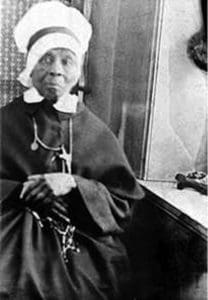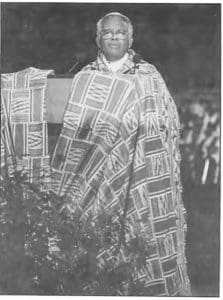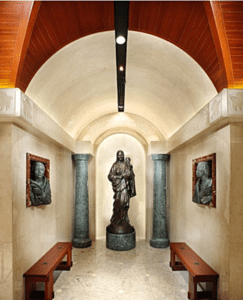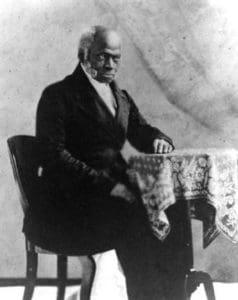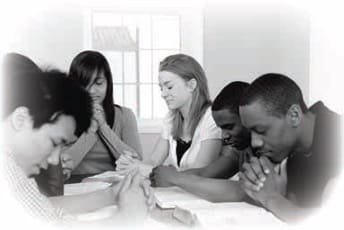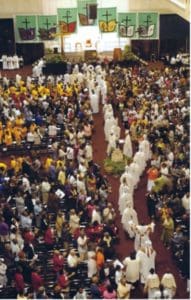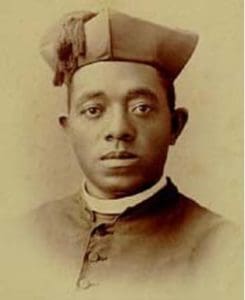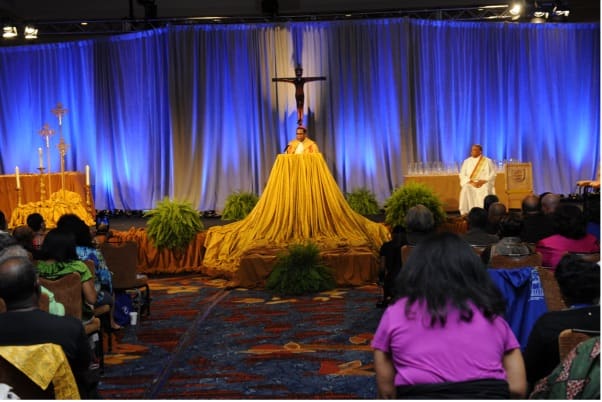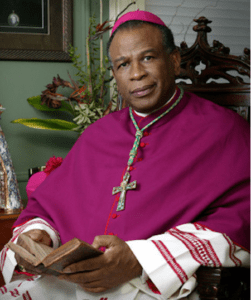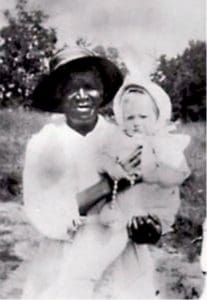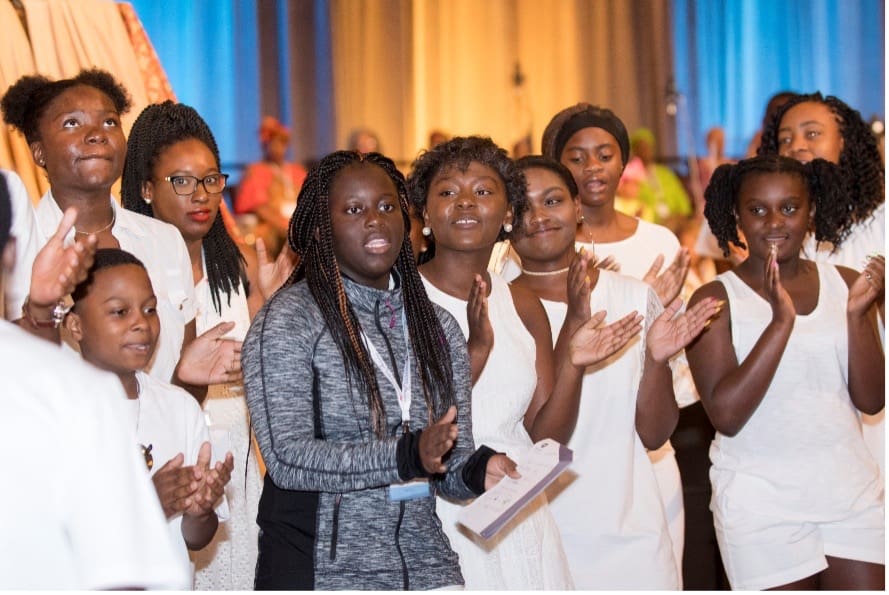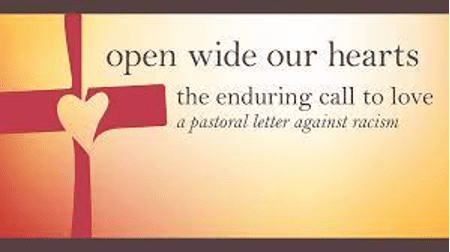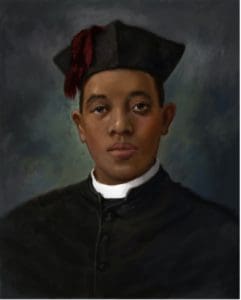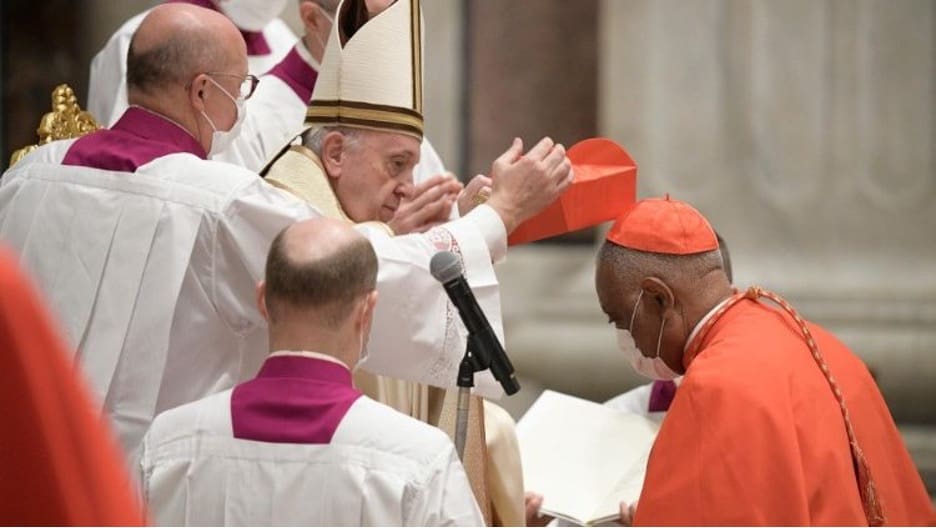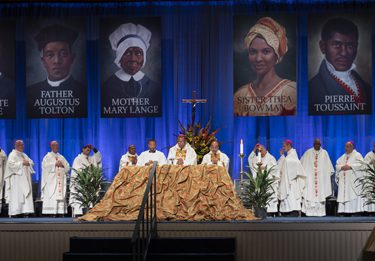
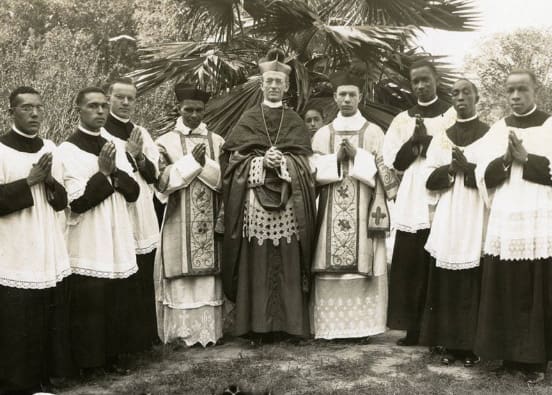
Black Catholic history timeline

Bay St. Louis, St. Augustine Seminary; Nov 1, 1936
Cool Timeline
Public Domain – Rare Book and Special Collections Division/Library of Congress, Washington, D.C.
Black people, both slave and free, help to found this oldest town in the United States. In 1693 Spain offers freedom to the slaves who convert to Catholicism. Until 1763, these freed slaves live in a community northeast of St. Augustine. Gracia Real de Santa Teresa de Mose, or Fort Mose, established in 1738, thus becomes the first free Black town in the U.S.
In 1693 Spain offers freedom to the slaves who convert to Catholicism. These freed slaves establish a community northeast of St Augustine in 1738 and live there until 1763. Gracia Real de Santa Teresa de Mose, or Fort Mose, becomes the first free Black town in the U.S.
Governor Don Felipe de Neve recruits 11 families to settle on the Porciuncula River–now Los Angeles. The settlers are all Catholic, a mix of Africans, Spanish, and American Indians.
Meanwhile, Maryland’s Black Catholic population grows to 3,000 as a result of Jesuit evangelization in the region, however, recent reports in the New York Times suggest the Jesuit order owned roughly 300 enslaved people, using the profits from sales to sustain the clergy and to finance the construction and the day-to-day operations of churches and schools.
Photo attributed to Paczilla007 at English Wikipedia., Public domain, via Wikimedia Commons
Pierre Toussaint had come to New York from modern-day Haiti with his owner in 1787 and become established as a well-known hairdresser. After his owner dies penniless, Toussaint supports his late owner’s wife through her emotional and physical ailments. Eventually she grants him his freedom. He uses his stable income to buy freedom for his sister and his future wife, and to support many individuals and charities including an orphanage and school for Black children. He cares for the ill when yellow fever sweeps the city, and opens his home to homeless youth. Pierre Toussaint is declared Venerable by Pope John Paul II in 1996.
Used with permission of the Oblate Sisters of Providence.
A handful of women from Baltimore’s Haitian refugee colony begin to educate local children in their homes. With the support of the archbishop, in 1829 they create the Oblate Sisters of Providence. The first superior is Elizabeth Lange, born in Cuba of Haitian parents.
Public domain, via Wikimedia Commons
In this 1839 apostolic letter “In Supremo Apostolatus,” Pope Gregory XVI condemns the slave trade as the “inhuman traffic in Negroes.” Rome outshines the U.S. in race relations from the 17th through the 20th centuries. Many U.S. bishops as well as men’s and women’s religious orders in this period own slaves, sometimes advocating for their proper treatment.
Used with the permission of the Sisters of the Holy Family
Founded by Henriette Delille and Juliette Gaudin in New Orleans, the Sisters of the Holy Family become the second religious order for Black women. Biracial and of African descent, the founders are free people of color, a separate class and culture above the slaves at that time. The order ministers to poor Blacks, educating and tending the sick. Henriette Delille is declared Venerable by Pope Benedict XVI in 2010.
Used with permission of Archive, Archdiocese of Boston
Although James Healy and his nine siblings—all fathered by a Georgia plantation owner—are officially slaves, their faith brings them north for education and freedom. Three of the Healy brothers—James, Patrick and Alexander—become the first African American priests in the U.S., although they do not identify with being Black and never speak on behalf of Blacks.
Photo from the NBCC Archives
Daniel Rudd, a journalist from Ohio and founder of the American Catholic Tribune, becomes a leader of Black laity. Fiercely proud of the Catholic Church, Rudd claims the Church is the one place of hope for Black people. Rudd recruits delegates for the first Black Catholic Congress, the first Black Catholic lay congress in U.S. history. In January 1889, almost 100 Black Catholic men meet with President Grover Cleveland on the last day of the congress.
Newspaper article from the NBCC Archives
The second Colored Catholic Congress is held in Cincinnati, OH from July 8-10. A call was made for the establishment of an Industrial School.
The 1892 Congress
The third Colored Catholic Congress is held in Philadelphia, PA from July 5-7. The gathering was tasked with drawing up a constitution for permanent organization (this action did not come to fruition until 1985). Pictured at center is Venerable Fr. Augustus Tolton.
The Field Museum Library, No restrictions, via Wikimedia Commons
The fourth Colored Catholic Congress is held in Chicago, IL from September 4-8, to address important issues such as discriminatory actions in Catholic schools, questions regarding repatriation of Negroes to Africa, and the establishment of separate schools and churches for Black people. The closing mass was attended by more than 5,000 people.
St. Peter Claver Catholic Church, Baltimore. From the Josephites archives.
The fifth Colored Catholic Congress convenes in St. Peter Claver Hall in Baltimore, MD from October 8-11. Dr. William Lofton, then President of the Congress, addressed the assembly: “We hope to hail the day…when the American people, the hierarchy of the Catholic Church, and the laity shall rise up in their might and stamp out the prejudice which is today destroying the life’s blood of the country.”
From the Knights of Peter Claver Archives, used with permission of the KofPC
The Knights of Peter Claver, a lay organization for Black Catholics, is established as a parallel to the Knights of Columbus. It soon develops chapters for women and young people. Today it is the largest African American lay Catholic organization in the United States.
Unknown photographer, Public domain, via Wikimedia Commons.
Led by Thomas Wyatt Turner, the Committee for the Advancement of Colored Catholics forms during World War I to care for Black Catholic servicemen neglected by both the Knights of Columbus and the black YMCA. After the war, the group broadens its focus. Its advocacy gives birth to a new national forum for Black Catholics. The U.S. bishops, despite requests from Rome to act on behalf of Blacks during the race riots and lynchings of 1919, avoid the topic at their first annual meeting. In response, the committee publicly urges the bishops to denounce discrimination and consult with Black Catholics, saying “at present we are neither a part of the colored world (Protestant), nor are we treated as full-fledged Catholics.”
Used with permission of the Franciscan Handmaids of the Most Pure Heart of Mary
The Georgia state legislature introduces a bill prohibiting whites from teaching Black students. Although the bill eventually fails, a community of Black sisters is formed to teach. In 1922 the sisters relocate to New York where they start a soup kitchen and begin educating local children. In 1929 they affiliate with the Franciscan Third Order, becoming the Franciscan Handmaids of the Most Pure Heart of Mary. Still active in Harlem, their ministries have spread elsewhere in the United States.
Used with permission of the Hancock County Historical Society
The Society of the Divine Word in Greenville, Mississippi, with the blessing of Pope Benedict XV, opens St Augustine’s Seminary, the first seminary for blacks. Some American bishops are still not convinced of the merit of a Black priesthood.
From the Knights of Peter Claver Archives. Used with permission of the KofPC.
The Order became an official division in 1926, and is the only fraternal order offering membership to men and women. The purpose of the Ladies Auxiliary is to render services to God and His Holy Church, to be faithful to its doctrines; sensitive to the needs of the Church, the family, fellow man and community.
Used with permission of Xavier University Archives
Xavier University in Louisiana (XULA), founded in 1925 by Katharine Drexel and known as the first Black Catholic University, dedicates its present campus on Palmetto St. (now Drexel Drive) on October 12, 1932.
Page from The Advocate newspaper
The American bishops denounce racial prejudice as immoral for the first time.
Many Catholic clergy and women religious join the march in Selma, AL, making the Church’s foray into the civil rights struggle for racial equality.
Unknown author, Public domain, via Wikimedia Commons
The cause for canonization of Pierre Toussaint is presented to the Vatican.
Used with permission of the NBCCC
Prior to the meeting of the Catholic Clergy Conference on the Interracial Apostolate in 1968, Father Herman Porter of the Diocese of Rockford, IL invites all U.S. Black Catholic clergy to a special caucus. More than 60 Black clergy gather to discuss the racial crisis and they decide to form a permanent organization. They send a statement to the bishops that strongly criticizes the church but is clear in its devotion and hope. The statement lists nine demands for the Church to be faithful in its mission to Blacks and restore itself in the black community. The National Black Catholic Clergy Caucus remains active today.
Pictured from top left to bottom right: Cardinal Wilton Gregory, Bishop Emerson Moore, Bishop Moses Anderson, Bishop J. Terry Steib, Bishop John Ricard, Bishop Joseph Francis, Bishop Harold Perry, Bishop Joseph Howze, Bishop Eugene Marino, and Archbishop James Lyke.
From the USCCB
The United States Conference of Catholic Bishops publishes Brothers and Sisters to Us, a pastoral letter on racism.
The Black Bishops of the United States publish What We Have Seen and Heard: A Pastoral Letter on Evangelization
The National Black Catholic Congress (NBCC) is re-established in 1985 as a coalition of Black Catholic organizations.
NBCC renews the tradition of gathering Black Catholics from across the country. The first renewed congress, Congress VI, takes place in May of 1987 in Washington, D.C. Since then the NBCC holds a national congress every five years, and each event attracts a growing number of attendees.
Wikipedia.com
The canonization process of Mother Henriette Delille is begun, and she is named a Servant of God.
Image is a still from the United States Conference of Catholic Bishops (USCCB) video, courtesy of the USCCB
Sr. Thea Bowman, addresses the U.S. Conference of Catholic Bishops in November 1989 from her wheelchair. In 1990, Sr. Thea Bowman passes into eternal life.
Unknown author, Public domain, via Wikimedia Commons
Mother Mary Lange’s cause for canonization was officially opened by William Cardinal Keeler, and she is proclaimed a Servant of God.
Bishop Joseph Francis, SVD, Auxiliary Bishop of Newark, NJ (now deceased) gave the homily at the opening liturgy. Photo from the In A Word archives.
The 7th National Black Catholic Congress gathering is held from July 9-12 in New Orleans, LA.
The Pastoral Plan resulting from this Congress provides comprehensive statements that address issues such as African American Family Life, the Sacramentality of Marriage, Children and Youth, among others.
Photo from NBCC Archives. One of the naves features a statue of Our Mother of Africa holding the infant, Jesus, while two of the four evangelists look on.
The 8th National Black Catholic Congress gathering is held from August 28-31 in Baltimore, MD.
This Congress celebrates the opening of the “Our Mother of Africa Chapel,” located within the Basilica of the National Shrine of the Immaculate Conception in Washington, DC.
Public domain, via Wikimedia Commons
On December 17, 1997, Pope John Paul II declares Pierre Toussaint venerable.
Photo from USCCB
(Collated in 2013) Love Thy Neighbor as Thyself: U.S. Catholic Bishops Speak Against Racism, is published.
From In A Word archives, Congress IX in 2002.
The 9th National Black Catholic Congress gathering is held from August 29-September 1 in Chicago, IL.
With a Declaration of Principles, the Congress IX assembly dedicates themselves to make an effort to embody the healing presence of God’s unconditional love to others and establish justice by living in patterns of the right relationships in a world challenged by human evil and sin.
The 10th National Black Catholic Congress gathering is held from July 12-15 in Buffalo, NY.
The theme of this Congress gathering, Christ is With Us: Celebrating the Gifts of the Sacraments, was inspired by the witness of our ancestors and gave proof of our gratitude for the gifts of our Catholic and African heritage.
Unidentified photographer, Public domain, via Wikimedia Commons
The Augustus Tolton cause for canonization is announced by Cardinal Francis George.
Photo from Wikipedia.com
Pope Benedict XVI declares Mother Henriette Delille venerable.
Photo from the NBCC Archives.
The 11th National Black Catholic Congress gathering is held in Indianapolis, IN.
Using the findings from a survey of Black Catholics conducted by the NBCC in cooperation with the University of Notre Dame, the Congress XI Pastoral Plan of Action specified ten areas African American Catholics are called to engage in their faith. The complete Pastoral Plan can be found here.
Photo courtesy of the Diocese of Belleville.
Most Rev. Edward K. Braxton, Bishop of the Diocese of Belleville, publishes two letters in response to the continued racial disparity in the United States: The Racial Divide in the United States: A Reflection for the World Day of Peace (2015); and The Catholic Church and the Black Lives Matter Movement: The Racial Divide in the United States (2016).
The Catholic Church and the Black Lives Matter Movement: The Racial Divide in the United States Revisited — Bishop Edward K. Braxton, 2016
The Racial Divide in the United States: A Reflection for the World Day of Peace— Bishop Edward K. Braxton, 2015.
The Faith Community: One, Holy, Catholic and Apostolic — Bishop Edward K. Braxton, 1990.
The Wisdom Community – Bishop Edward K. Braxton, 1980
Photo courtesy of CNS/Karen Callaway
The remains of Servant of God (at that time) Augustus Tolton are exhumed and verified
The cause for canonization of Julia Greeley is officially opened by Archbishop Samuel Aquila.
Photo from the NBCC Archives
The Twelfth National Black Catholic Congress gathering is held from July 6-9, in Orlando, Florida. A Pastoral Plan Committee, working together over the course of the Congress gathering, identified seven topics that they believed were critical for Black Catholics to address over the next five years. The Pastoral Plan was issued, along with an implementation guide, to provide ideas and inspiration to parishes for action on these important topics.
During the November 2018 General Assembly, the U.S. Bishops approve Open Wide Our Hearts: The Enduring Call to Love, A Pastoral Letter Against Racism.
During the November 2018 General Assembly, the Bishops also approve Sr. Thea Bowman’s cause for canonization, after she is declared a Servant of God in June 2018.
©NBCC, 2019
Fr. Augustus Tolton is declared Venerable by Pope Francis.
Photo courtesy of Vatican Media
Pope Francis names Wilton Gregory cardinal, elevating him as the first African American to serve in that capacity.
Photo from the NBCC Archives
The Thirteenth National Black Catholic Congress gathering is held from July 20-23, 2023, in National Harbor, MD. His Eminence Wilton Cardinal Gregory gave the Opening Keynote Address and celebrated the Opening Mass at the National Shrine of the Immaculate Conception. The Pastoral Plan was issued, along with an implementation guide, to provide ideas and inspiration to parishes for action over the next five years.
Noteworthy Historical Figures
Black Catholic Saints
Discover more stories about Black Catholic saints and the heroic men and women on the path to canonization.

